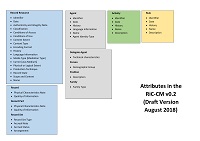Conceptual Model Group Attributes
Summary
Attributes are the properties or characteristics of an entity. In the Records in Context- Contextual Model, different entities may have unique Attributes specific to the domain of that entity type, or it may Attributes that it shares with other entities. These Attributes (arranged by their "domain") are as follows:
Activity
Shared Attributes
Identifier
Date
History
Name
Description
Agent
Shared Attributes
Identifier
Date
History
Language Information
Name
Agent Identity Type
Attributes Specific to Delegate Agent
Technical Characteristics
Attributes Specific to Family
Family Type
Attributes Specific to Person
Demographic Group
Attributes Specific to Position
Description
Record Resource
Shared Attributes
Identifier
Date
Authenticity and Integrity Note
Classification
Conditions of Access
ConditionsOfUse
Content Extent
Content Type
Encoding Format
History
Language Information
Media Type [Mediation Type]
Carrier [was Medium]
Physical or Logical Extent
Production Technique
Record State
Scope and Content
Name
Attributes Specific to Record
Physical Characteristics Note
Quality of Information
Physical Characteristics Note
Attributes Specific to Record Part
Quality of Information
Attributes Specific to Record Set
Record Set Type
Accrual Note
Accrual Status
Arrangement
Rule
Shared Attributes
Identifier
Date
History
Name
Description
Skip to
Details
Example 1. Attributes of The William I Charter
(Retrieved from: The London Metropolitan Archives Online Catalogue).Identifier:
COL/CH/01/001/ADate:
Circa 1067Authenticity and Integrity Note:
The charter bears the seal of the King of England.Classification:
City of LondonConditions of Access:
Available only with advance notice and at the discretion of the London Metropolitan Archives (City of London) DirectorConditions of Use:
(not researched)Content Extent:
5 lines of textContent Type:
TextEncoding Format:
Not applicableHistory:
The charter was drawn up soon after William's coronation in Westminster Abbey in December 1066. Following the Battle of Hastings in October 1066 William had subjugated much of the south-east of England as he marched towards London. With the City of London however he used a different approach, recognising the importance of safeguarding its wealth and international trading links. A peaceful agreement with Londoners was reached, seen in this charter which is written in Old English (not William's native Norman French) and in the established form of administrative letter used by English kings.This charter was sent to the City of London by King William I in circa 1067 and has been in the London Metropolitan Archives (previously known as the Greater London Record Office) ever since.
Language Information:
Old EnglishMedia Type:
Parchment charterCarrier:
(We are unclear what carrier refers to)Physical or Logical Extent:
6 inches x 1.5 inches.Production Technique:
HandwrittenRecord State:
OriginalScope and Content:
This charter is the oldest document in the archive of the City of London Corporation.The charter bears the earliest surviving impression of the seal of the new King of England.
It is the earliest known royal document in Europe to guarantee the collective rights of all (not just a specific group of) the inhabitants of a town.
Name: Royal Writ [The "William I Charter"]
Physical Characteristics Note: Seal is imperfect, detached and conserved. Parchment is partly torn.
Quality of Information:
Ink has slightly faded, particularly on first letter. Text is still easily legible.
Related entries
Digital resources
Gavan McCarthy
Created: 17 May 2018, Last modified: 17 August 2018

